Welcome to our blog on Pangasius fish farming cost and profit analysis! In this post, we will delve into the economics of Pangasius fish farming and provide you with a comprehensive project report. Pangasius farming is a lucrative venture and an environmentally sustainable option. Let’s check out the project report of Pangasius fish farming below.
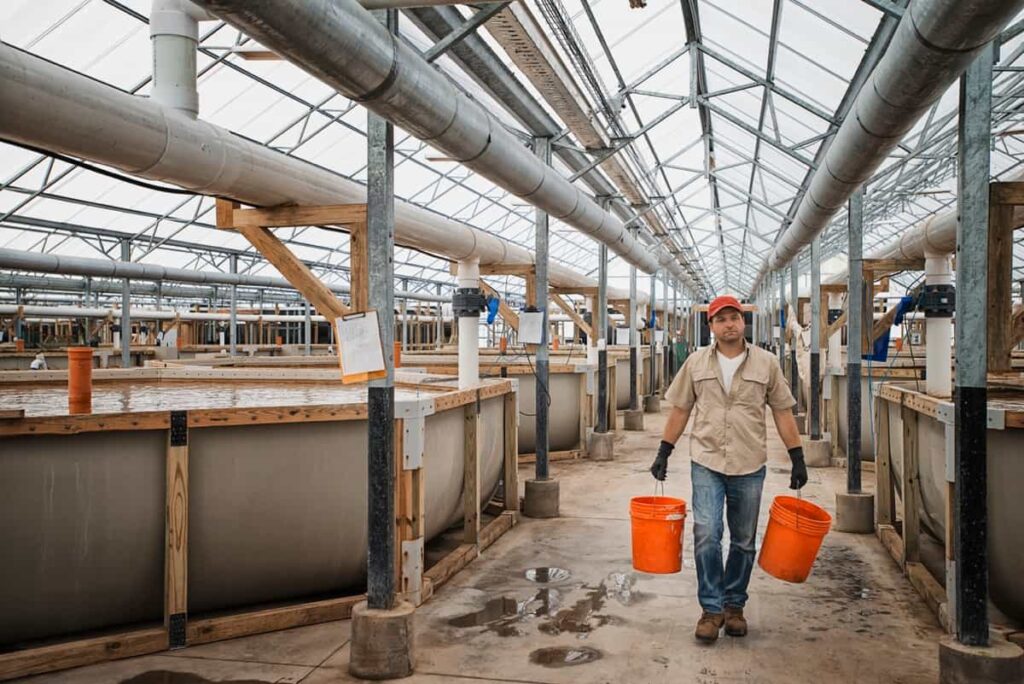
We will explore the initial investment required, operational costs, market prices, and potential profits in this thriving industry. Whether you’re a seasoned fish farmer or considering entering the aquaculture sector, this blog will equip you with valuable insights and a clear understanding of the financial aspects of Pangasius fish farming.
What is Pangasius Fish Farming?
Pangasius fish farming involves cultivating a species known as river or silver striped catfish, Siamese shark, sutchi catfish, or swai catfish. This fish is predominantly found in freshwater and is native to the Mekong basin. Pangasius has a streamlined body with a dark grey back, silver belly, wide mouth, and long twin beard. It possesses unique characteristics such as more red blood cells than other fish, a different respiratory organ, and the ability to breathe through bubbles and skin.
These adaptations allow it to survive in environments with low dissolved oxygen levels. Pangasius farming is driven by its high market demand, rapid growth rate, and its status as the third most important freshwater fish group in the aquaculture sector. This farming practice is prevalent in Thailand, Nepal, Pakistan, India, Bangladesh, Vietnam, Laos, Myanmar, Indonesia, and Cambodia.
Pangasius can be cultivated in various environments, including ponds, concrete tanks, fish cages, or pens. Its growth rate is impressive, reaching 10-12cm in length and 14-15 grams in weight within approximately two months of breeding. It can live for up to 20 years in the wild and reach a weight of around 25kg in farming ponds by age 10. The best harvesting size is typically between 800-1,100 grams, achieved within 6-8 months (excluding the breeding stage).
In case you missed it: Project Report of RAS Fish Farming: Production Economics, Cost, and Profit Analysis
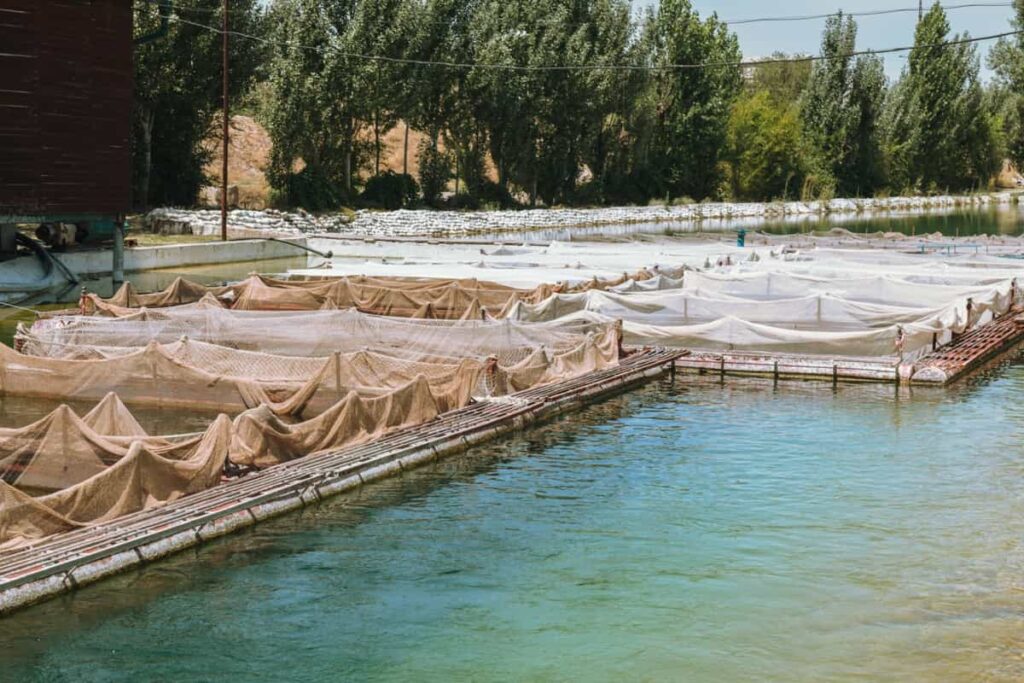
Farming of Pangasius Fish
- Pangasius is primarily reared in ponds and cages, with high stocking densities of around 60-80 fish per square meter. It takes approximately 6-8 months for them to reach their harvest weight of about 1kg.
- Both male and female Pangasius grow at similar rates and reproduce at temperatures between 26 and 28°C. The spawning period occurs from February to October, and sexual maturity is typically reached at 3-3.5 years of age.
- Pangasius are highly fecund, with females capable of producing up to 80,000 eggs per kilogram and spawning multiple times. Pond production yields can reach around 250-300 metric tons per hectare, more than four times that of other aquaculture species.
- Cage production is conducted in impoundments, lakes, or rivers, with stocking densities of about 100-150 fish per cubic meter. Yields from cages can reach approximately 100-120 kilograms per cubic meter. Floating cages facilitate continuous water exchange and enable higher fish densities and productivity.
- Pangasius is commonly exported as skinless, boneless fillets, with flesh color varying from white, cream, and yellow, to rose, influenced by feed, processing, culture conditions, and the environment.
- By-products of Pangasius, such as fishmeal, bio-diesel, and cosmetics, are utilized in various applications. The fish’s medium-firm, fine-grained flesh with a mild flavor makes it suitable for value-added products.
- Environmental concerns have been addressed in Pangasius farming, including reducing fry collection from the Mekong River to preserve natural fisheries. Farms now need to provide information on potential environmental impact before commencing operations.
- Pangasius shows potential advantages in reproductive capacity, tolerance to low dissolved oxygen, and high production yields.
Market Potential and Demand for Pangasius Fish Farming
- The global fish supply has increased from 60 million tonnes in 1970 to 170.9 million tonnes in 2016, with aquaculture driving the growth due to overexploitation of capture fisheries.
- Aquaculture production has risen from less than 1 million tonnes in 1950 to 80.0 million tonnes in 2016, with developing countries contributing 92.5% and Asia supplying 89% of global aquaculture production.
- In Bangladesh, total aquaculture production has increased from 787 thousand MT in 2001-2002 to 2405 thousand MT in 2017-18. Pangasius is a major species, contributing about 10.6% of total fish production.
- Pangasius is fast-growing, adaptable to various cultural patterns, and popular among farmers. It is also a low-cost food fish for people experiencing poverty in Bangladesh.
- Efficient resource utilization and input-output combinations are crucial for maximizing profits, but small-scale farmers need more institutional constraints and more access to credit.
- Farm size can also impact profitability, and the relationship between farm size and productivity varies within the aquaculture industry.
- Studies on profitability in pangasius fish farming are limited, and assessing pangasius production’s long-term sustainability and profitability is important.
In case you missed it: Project Report of Biofloc Fish Farming: Production Economics, Cost, and Profit Analysis
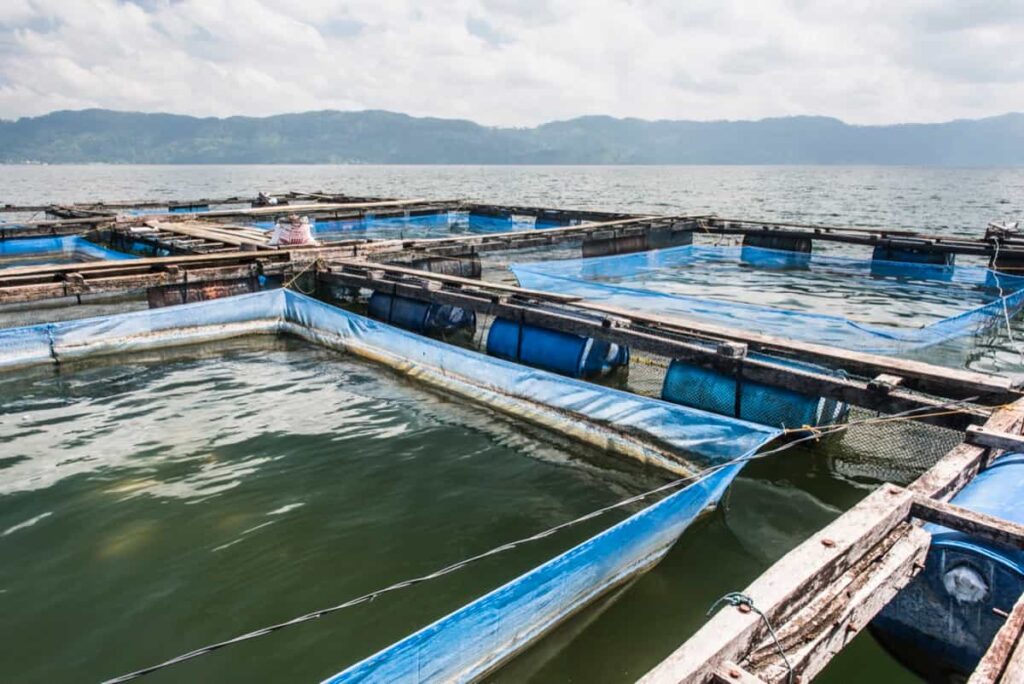
Technical Parameters of Pangasius Culture
- Due to its high development rate, adaptability, compatibility with carp, and environmental friendliness, Pangasius sutchi, commonly known as Sutchi river catfish or Bocourts catfish, has tremendous cultural potential in India. It may be farmed in ponds, seasonal tanks, abandoned shrimp ponds, fish pens/cages, canals, reservoirs, and low-salinity environments, among other places.
- Infections such as hemorrhagic septicemia, bacillary infections, Flavobacterium column, and Trichodine may affect both farmed and wild stocks of Pangasius sutchi. However, no major illnesses have been reported during cultivation.
- Pangassius sutchi has a high marketability because it lacks intramuscular bones, making it easier to fillet. The species has enormous local and worldwide market potential, and India’s massive infrastructure and competence in shrimp processing and exporting can capitalize on the international market.
- Pangassius sutchi cultivation sites should be carefully selected, considering location, water quality, pollution, disturbance, poaching, and uninterrupted power supply.
- The optimal pond size and depth should be 1 hectare and 1.5-2 meters, respectively.
- Pond preparation and management include emptying and sun drying the pond, mending dykes and gates, removing predators, liming the pond soil, and filling the pond with 1.5 to 2 meters of water.
- Pangassius sutchi can be cultivated in both monoculture and polyculture systems, with monoculture limited to semi-intensive stocking densities of fewer than 20,000 advanced fingerlings (15-20 gm/ha) and polyculture at rates of 12-14 tons/ha.
- Pangassius sp. survival rate is predicted to be 80-90% when stocking is done early morning or late afternoon.
Feed Management of Pangasius Fish Farming
- Pangasius fish can be fed with various types of feed, including kitchen waste, rice bran, or pelleted feeds.
- Pelleted feeds are recommended for faster growth and better flesh quality.
- The feeding rate should be around 2.5-3% of the Average Body Weight (ABW) and monitored and adjusted every two weeks.
- The Feed Conversion Ratio (FCR) for Pangasius averages 2.35:1, which is considered suitable for cultivation.
- Pangasius is initially omnivorous, consuming plants and animals during its first year, but becomes herbivorous in the following years.
- Wet feeds should be avoided in the culture of Pangasius.
- Floating pellets are desirable as it promotes better growth, improved meat quality, health, and better pond water and soil management.
- Achieving an FCR of less than 2.35:1 is important, and using floating pellets can contribute to this goal.
- In polyculture systems, high-quality mashed feeds can also be used in addition to floating pellets, delivered through bag feeding.
In case you missed it: Fish Farm Operations Management: Month-wise Maintenance for Better Profits
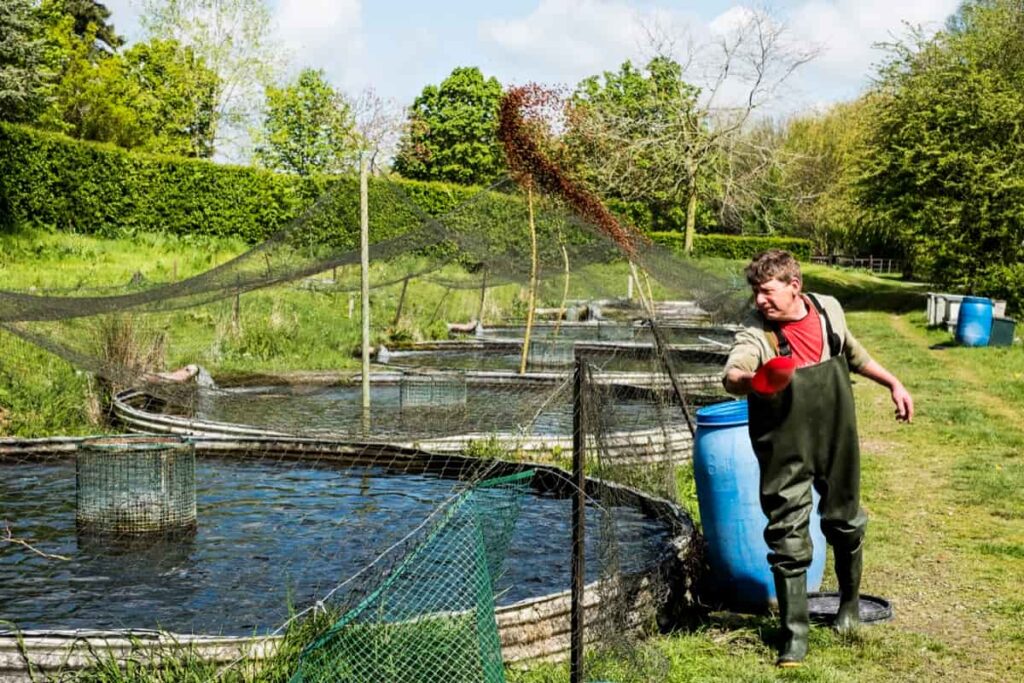
Feed Storage and Water Management of Pangasius Fish Farming
Feed Storage
- A feed storage facility should be available at the farm site, ensuring adequate ventilation and fumigation.
- The feed should be stored on raised wooden platforms, keeping them away from the walls to prevent molding.
- Using the feed within three months from the production date is recommended.
Water Management
- Maintaining quality water is crucial for successful fish culture.
- Important water quality parameters for Pangasius include pH (6.5 – 7.5), Dissolved Oxygen (DO) (0.1 mg/l), temperature (25-30°C), salinity (< 2 ppt), and water depth (1.5 – 2m).
- To achieve higher yield levels, efforts should be made to maintain these parameters within the specified ranges.
- Pangasius species are air-breathing fish, so they do not require excessively high levels of Dissolved Oxygen in the water.
Harvesting, Post-Harvest, and Transport of Pangasius Fish Farming
Harvesting
- Harvesting in Pangasius fish farming can be either partial (selective harvesting) or total harvesting.
- The culture period for harvesting Pangasius is typically around 8-10 months.
- With proper pond management, Pangasius can reach a weight of 1-1.5 kilograms within 8-12 months of culture.
Post-Harvest and Transport
- Once harvested, it is essential to immediately ice the fish to maintain freshness.
- The harvested fish should be transported to domestic markets or processing plants using reefer or refrigerated vans.
Economics and Project Report on Pangasius Fish Farming
- Pangasius fish farming can be economically viable due to its high growth rate and market demand.
- The initial investment for setting up a Pangasius fish farm includes costs for land, pond construction, water supply, fingerlings, feeds, and equipment.
- Operational costs involve expenses for labor, feeds, electricity, water management, and disease control.
- The revenue in Pangasius fish farming mainly comes from selling harvested fish.
- The project’s profitability depends on pond management, feed conversion ratio, market price, and operational efficiency.
- A detailed project report should include a feasibility study, financial analysis, market research, production plan, and risk assessment.
- The project report should also outline the expected return on investment, payback period, and break-even analysis.
- Proper record-keeping and financial management are crucial for monitoring the economic performance of the Pangasius fish farming project.
- Continuous monitoring and evaluation of the project’s economics can help identify section for improvement and optimize profitability.
Cost Analysis of Pangasius Fish Farming
Different factors can influence the cost of production in Pangasius fish farming. These factors include the cost of land or pond leasing, pond construction and preparation, water supply and management, fingerlings or seed procurement, feeds, and feeding practices, labor wages, electricity expenses, disease prevention, and control measures, and transportation costs.
Other contributing factors include the cost of equipment and machinery, maintenance and repairs, administrative expenses, marketing, and promotional activities, and any additional costs associated with regulatory compliance. This cost analysis includes site preparation, pond construction, equipment and machinery, fish seed procurement, feed expenses, operational costs, and miscellaneous expenses. Capital investment and ongoing operational expenses are required for Pangasius fish farming in a 1-hectare area.
In case you missed it: A Guide to Sustainable RAS Fish Farming Practices
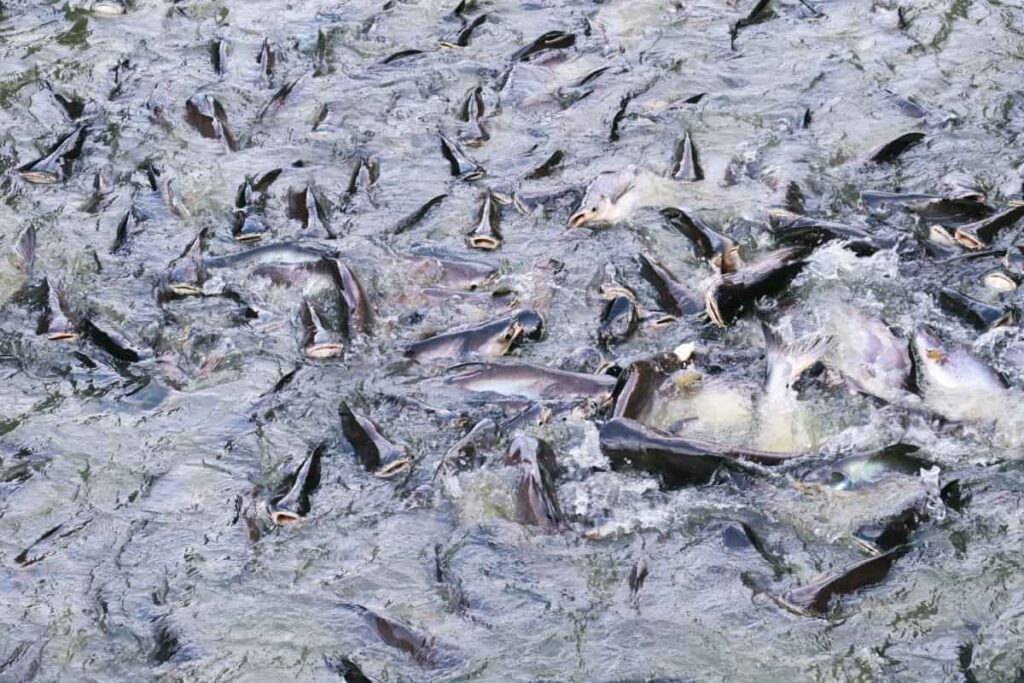
Project Report of Pangasius Fish Farming in a 1-hectare Area
| Description | Cost (Rs.) |
| Capital cost | |
| Site clearance | 4,000 |
| Pond construction | 75,000 |
| Diesel Pump Set (5HP) | 60,000 |
| Inlet/outlet sluices | 7,000 |
| Nets and other implements | 6,500 |
| Miscellaneous expenses | 4,500 |
| Total Capital Cost (A) | 1,57,000 |
| Miscellaneous expenses, including harvesting charges | |
| Drying, desilting, and ploughing | 4,500 |
| Lime | 2,500 |
| Pangasius fish seed | 13,000 |
| Fish feed (Oil cake & Rice bran) | 4,38,000 |
| Pumping charges (electricity/diesel) | 60,000 |
| Watch and ward | 24,000 |
| Miscellaneous expenses, including harvesting charges | 15,000 |
| Total Operational Cost (B) | 5,57,000 |
| Total Cost (A + B) | 7,14,000 |
Capital investment and ongoing operational expenses required for Pangasius fish farming in a 1-hectare area cost around 7,00,000 lakhs covering site preparation, pond construction, equipment and machinery, fish seed procurement, feed expenses, operational costs, and miscellaneous expenses.
Returns and Profit Analysis of Pangasius Fish Farming
Returns and profit analysis of Pangasius fish farming involves evaluating the income generated from selling the fish compared to the total cost incurred. Factors contributing to profitability include market demand, fish growth rate, feed conversion ratio, fish survival rate, and selling price. Efficient management practices and economies of scale can also impact profitability.
Returns from Production
- Survival rate: 90% (11,700 fish)
- Average weight at harvest: 1,500 grams (15,210 fish)
- Total production: 15,210 kilograms
| Farm gate price | Rs. 50 per kilogram |
| Number of crops per annum | 1 |
| Income during the first year | Rs. 7,60,000-8,00,000 |
| Present Worth of Costs at 15% Discount Factor | Rs. 33.42 |
| Present worth of benefits at 15% Discount Factor | Rs. 43.53 |
| Net present worth (PW of Benefits – PW of Costs) | Rs. 10.11 |
| Benefit cost ratio (PW of Benefits / PW of Costs) | 1.30:1 |
| Benefit-cost ratio (PW of Benefits / PW of Costs) | > 50% |
In case you missed it: Fish Hatchery Business Plan: How to Start, Cost, Profits, and a Great Way to Make Money
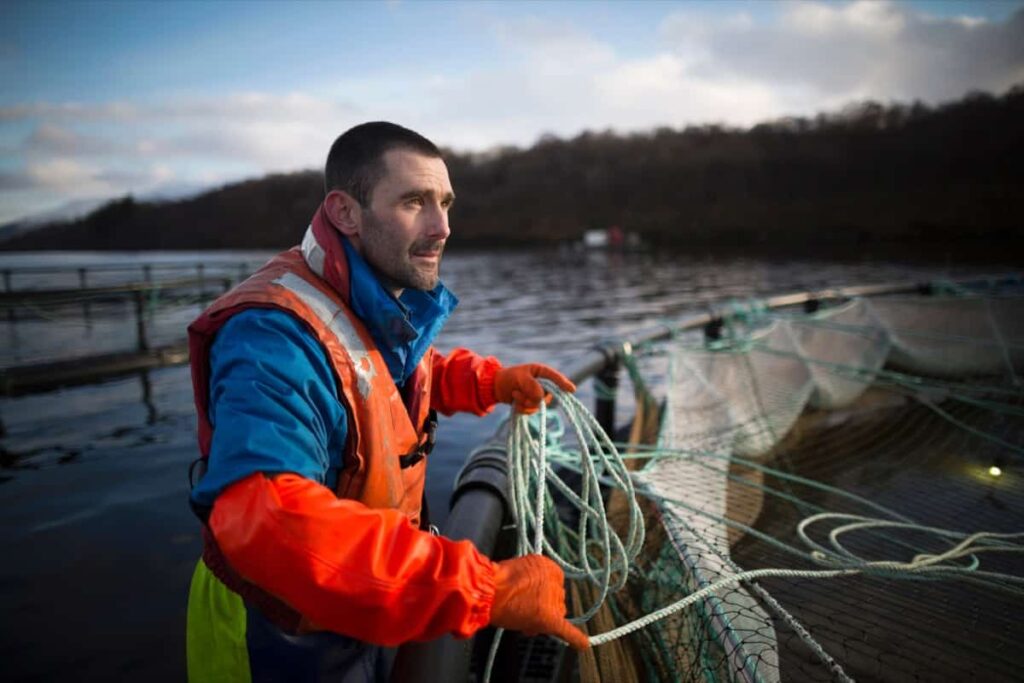
Pangasius fish farming in a 1-hectare area can generate positive returns and profitability, with a net benefit and a favorable benefit-cost ratio. The analysis shows a steady gross and net benefit over the years, indicating the potential for sustainable profitability in the long run. The internal rate of return is greater than 50%, further suggesting the attractiveness of the investment in Pangasius fish farming.
Conclusion
The cost and profit analysis of Pangasius fish farming demonstrates its potential for profitability. With favorable returns, a positive net benefit, and a high benefit-cost ratio, investing in Pangasius fish farming can be economically rewarding.
- Management Pests and Diseases in Your Cotton Field
- Sheep Farming Business Plan for Beginners
- Aquaponic Farming at Home: A Step-By-Step Guide
- Profitable Village Farming Business Ideas in 2024
- High-Yield Aquaculture: Fast-Growing Fish for Farming
- Effective Fish Pond Construction Techniques for Beginners
- Irrigation and Water Management in Pineapple Farming
- Blossom to Harvest: Mastering Flowering and Pollination in Papaya Farming
- Pig Fattening Essentials: From Selection to Sale for Beginners
- Raising Wagyu Cattle: A Complete Guide for Premium Beef Production
- Soil Types and Their Water Holding Capacity
- Optimizing Irrigation Schedules for Coconut Groves for Enhanced Yield
- Espresso Your Garden: Coffee Grounds for Healthier Acid-Loving Plants
- The Best Soil Mix for Snake Plants: How to Mix Your Own Snake Plant Soil
- Green Thumb Success: Expert Tips for Cultivating Greenhouse Beans All Year Round
- Bloom All Year Round: The Ultimate Guide to Indoor Hyacinth Care
- Eco-Friendly Gardening: How to Make Liquid Fertilizer from Kitchen Waste
- Ultimate Guide to Grow Anise in Pots: Explore Seed Propagation to Harvesting
- Guide to Raising Chester White Pigs: Discover Breed Facts to Growth Management
- Mastering the Elegance: The Ultimate Guide to Weeping Cherry Tree Care, Planting, and Maintenance
- Ultimate Guide to Planting Garlic in Grow Bags: Growing Strategies for Beginners
- How to Fix Spider Plant Leaf-Related Problems: Natural and Organic Remedies
- 10 Reasons Why Your Tulsi Plant is Shedding Leaves: Home Remedies and Solutions
- Optimizing Growth and Yield: The Advantages of Palm Bunch Ash Fertilizer
- Utilizing Neem Oil Extract as a Natural Pesticide for Hydrangea
- From Soil to Harvest: Various Ways in Which Farmers Can Use AI Tools
- Steps to Encourage and Induce Citrus Flowers: A Comprehensive Guide
- How to Fix Snake Plant Leaf-Related Issues: Natural and Organic Remedies
- Transform Your Garden into a Fragrant Oasis with Raat Ki Rani (Night Blooming Jasmine)
- Discover the Ideal Chicken Breeds for Philippine Farms
- How to Create a Poultry Egg Farm Business Plan for Profits
- Grow Lemon Cucumbers Like a Pro: Insider Techniques for Bountiful Yields
- Ultimate Guide to Caring for Your Pink Princess Philodendron: Tips for Thriving Variegation
- Areca Nut Profit Per Acre: Calculating Yield and Cost of Cultivation
- How Kaveri Chicken is Becoming a More Profitable Breed in Indian Backyards
- Transform Your Barn: 9 Steps to Convert a Horse Stall into a Chicken Coop
